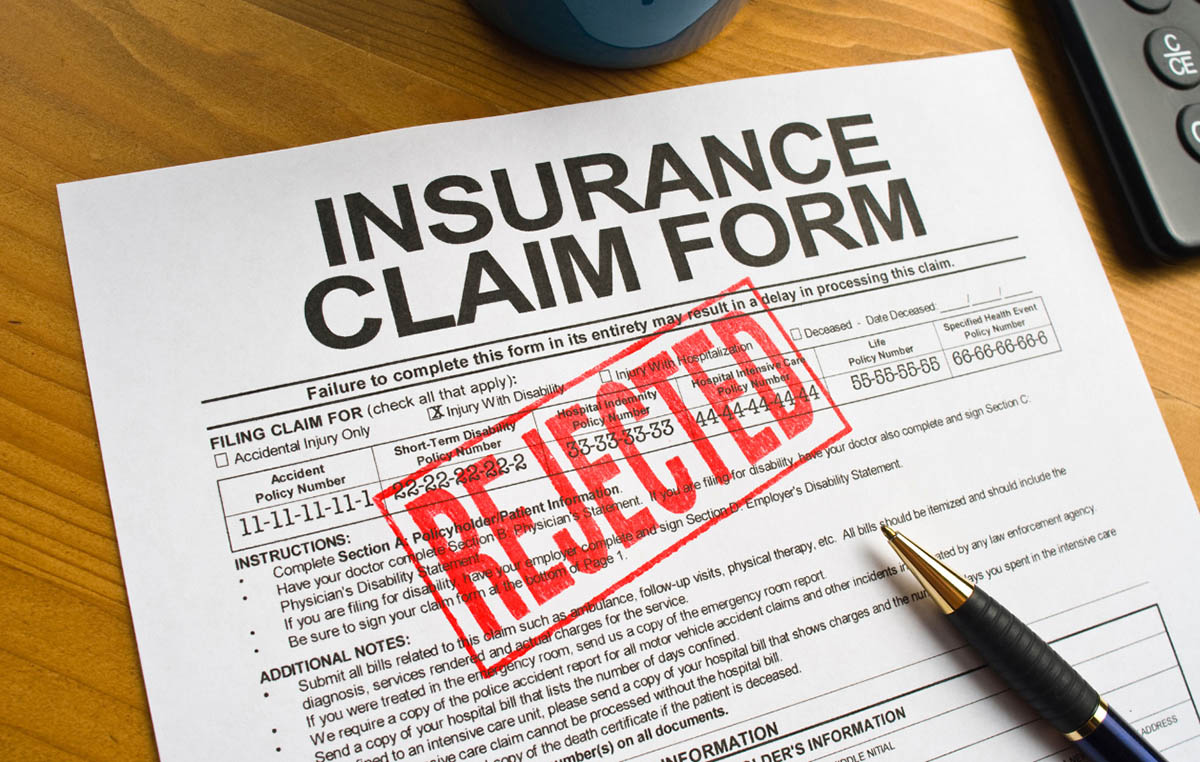

Finance
How To File An Insurance Claim With USPS
Modified: February 21, 2024
Learn how to file an insurance claim with USPS to protect your finances. Follow our step-by-step guide and ensure a smooth claim process.
(Many of the links in this article redirect to a specific reviewed product. Your purchase of these products through affiliate links helps to generate commission for LiveWell, at no extra cost. Learn more)
Table of Contents
Introduction
Welcome to our comprehensive guide on how to file an insurance claim with USPS. Accidents can happen, and when it comes to shipping valuable items or important documents, it is essential to have insurance coverage. USPS (United States Postal Service) offers insurance options to protect your packages and mail from loss, damage, or theft during transit.
While USPS takes great care in handling packages, incidents can still occur. If you find yourself in a situation where your mail or package has been damaged, lost, or stolen, filing an insurance claim is the next step to ensure you receive the compensation you deserve. This guide will walk you through the process of filing an insurance claim with USPS, from gathering the necessary documents to tracking your claim status.
It’s important to note that USPS has specific guidelines and requirements for filing insurance claims, and following these steps will help facilitate the process and increase the likelihood of a successful claim. Whether you are shipping items for personal or business purposes, understanding the insurance claim procedure with USPS can save you time, money, and stress.
Before we dive into the step-by-step process, it’s essential to have a clear understanding of the types of insurance coverage offered by USPS. There are different insurance options available based on the value of the items being shipped, such as Priority Mail Insurance, Registered Mail Insurance, and Express Mail Insurance. Each insurance option has its own coverage limits and requirements, so it’s crucial to select the appropriate insurance plan based on the value and nature of your shipment.
Now that we have clarified the importance of insurance when shipping with USPS let’s move forward and explore the step-by-step process of filing an insurance claim. Remember, accidents happen, but with the right knowledge and documentation, you can protect yourself and ensure a smooth insurance claim process.
Step 1: Gather Required Documents
Before initiating the insurance claim process with USPS, it’s crucial to gather all the necessary documents to support your claim. These documents will serve as evidence and provide USPS with the information they need to assess your claim accurately. Here are the essential documents you will need:
- Proof of Insurance: Start by locating the proof of insurance document that you received when you purchased the insurance coverage for your shipment. This document serves as proof that you have insurance protection for the specific package.
- Receipts or Invoices: Gather any receipts or invoices related to the items being shipped. These documents should clearly state the value of the items and serve as evidence of their worth.
- Photos: Take clear and detailed photos of the damaged items and packaging. These photos will help support your claim by providing visual evidence of the condition of the items before and after transit.
- Proof of Purchase: If the damaged items were purchased, gather any proof of purchase, such as receipts, invoices, or order confirmations. These documents will validate the purchase and value of the items.
- Tracking Number: Locate the tracking number associated with the shipment. This number is essential for USPS to track the package’s journey and verify its status.
- Personal Identification: Prepare a copy of your identification document, such as a driver’s license or passport. This document will help verify your identity as the shipper and claimant.
- Any Additional Documentation: If there are any other relevant documents related to the shipment or insurance coverage, make sure to gather and include them in your claim. This may include email correspondences, communication with USPS, or any other relevant information.
By gathering these required documents before starting the claim process, you will be well-prepared to provide USPS with the necessary information and evidence to support your claim. It’s crucial to keep these documents in a safe place, as losing or misplacing them can delay the claim process.
Now that you have gathered all the required documents let’s move on to the next step: identifying the type of claim you need to file with USPS.
Step 2: Identify the Type of Claim
Once you have gathered all the necessary documents, the next step in the insurance claim process with USPS is to identify the specific type of claim you need to file. USPS offers different types of insurance coverage, and the type of claim you file will depend on the nature of the damage, loss, or theft incurred during transit. Here are the common types of claims you may encounter:
- Damage Claim: If your package arrives at its destination damaged, this type of claim is applicable. Damage claims can include items that are broken, crushed, or otherwise impaired during transit.
- Loss Claim: If your package is completely lost and does not reach its destination, you will need to file a loss claim. This occurs when USPS is unable to locate the package within a reasonable amount of time.
- Theft Claim: If your package is stolen or shows signs of tampering, you will need to file a theft claim. This applies when the package is delivered, but its contents are missing or have been compromised.
It’s important to accurately identify the type of claim you need to file with USPS, as each type requires different documentation and procedures. When documenting the damage or loss, be sure to take photos and thoroughly describe the condition of the items as evidence to support your claim.
Once you have determined the type of claim, you can move on to the next step: completing the claim form. In the claim form, you will provide USPS with specific details about the shipment, including the value of the items, the tracking number, and a detailed description of the damage, loss, or theft.
Now that you understand the different types of claims available let’s proceed to the next step: completing the claim form with USPS.
Step 3: Complete Claim Form
After identifying the type of claim you need to file with USPS, the next step is to complete the claim form. The claim form is a crucial document that provides USPS with the necessary information to assess and process your insurance claim. Here’s how you can complete the claim form:
- Access the Claim Form: Visit the USPS website and navigate to the claims section. Look for the specific claim form related to the type of claim you need to file.
- Provide Shipment Details: Start by providing the tracking number associated with the shipment. This will help USPS locate the package and gather relevant information about its journey.
- Describe the Damage, Loss, or Theft: In this section, provide a detailed description of the damage, loss, or theft that occurred during transit. Be specific, accurate, and include any relevant details that can support your claim.
- Indicate the Value of the Items: Specify the value of the items being claimed. If you have receipts or invoices, refer to them to determine the accurate value. Include any additional costs incurred, such as shipping fees or insurance fees.
- Attach Supporting Documentation: Upload the photos and any other supporting documentation that you gathered in Step 1. These documents will validate your claim and provide evidence of the condition of the items before and after transit.
- Include Contact Information: Provide accurate and up-to-date contact information, including your name, phone number, email address, and mailing address. This will allow USPS to communicate with you regarding your claim.
It’s crucial to be thorough and accurate when completing the claim form. Any missing or incomplete information may result in delays or complications in processing your claim. Take your time to review the form before submitting it to ensure all details are correct.
Once you have completed the claim form, you can move on to the next step: providing supporting documentation to substantiate your claim.
Now that you have completed the claim form, let’s proceed to the next step: providing supporting documentation to substantiate your claim.
Step 4: Provide Supporting Documentation
After completing the claim form, the next step in the insurance claim process with USPS is to provide supporting documentation. These documents serve as evidence to substantiate your claim and validate the details provided in the claim form. Here’s what you need to do:
- Submit Photos: Include clear and detailed photos of the damaged items and packaging. The photos should clearly show the extent of the damage incurred during transit. If you have photos taken before shipping, include those as well to demonstrate the original condition of the items.
- Attach Receipts or Invoices: Include any receipts or invoices related to the items being claimed. These documents should clearly indicate the value of the items and validate their worth.
- Submit Proof of Purchase: If applicable, provide any proof of purchase, such as receipts, invoices, or order confirmations, for the damaged or lost items. This documentation will serve as evidence of the item’s value and ownership.
- Include Proof of Insurance: Ensure that you include a copy of the proof of insurance document that you received when you purchased the insurance coverage for the shipment. This document will validate that you have insurance protection for the specific package.
- Attach Any Additional Documentation: If there are any other relevant documents that support your claim, include them as well. This may include email correspondences, communication with USPS, or any other pertinent information that can bolster your case.
It’s important to organize and label your supporting documentation clearly. Ensure that the photos are of high quality and any text in receipts or invoices is legible. Keep the original copies of these documents for your own records in case they are requested by USPS during the claims process.
By providing the necessary supporting documentation, you increase the chances of a successful claim. These documents provide USPS with the evidence they need to assess the claim accurately and determine the appropriate compensation.
Once you have gathered and organized your supporting documentation, you can move on to the next step: submitting the claim to USPS.
Now that you have provided the supporting documentation, let’s proceed to the next step: submitting the claim to USPS.
Step 5: Submit the Claim
After completing the necessary documentation, the next step in the insurance claim process with USPS is to submit your claim. Once you have gathered all the required information and supporting documentation, follow these steps to submit your claim:
- Visit the USPS Website: Go to the USPS website and navigate to the claims section. Look for the specific claim submission page.
- Input Claim Details: Fill in the required fields on the claim submission form, such as the tracking number, claimant information, and description of the damage, loss, or theft.
- Upload Supporting Documentation: Attach the supporting documentation you gathered in Step 4. This may include photos of the damaged items, receipts or invoices, proof of purchase, proof of insurance, and any additional relevant documents.
- Review and Verify Information: Double-check all the information provided on the claim submission form to ensure accuracy. Review the attached documents to make sure they are clear and legible.
- Submit the Claim: Once you have reviewed and verified all the information, submit your claim to USPS by clicking the appropriate button. Take note of any confirmation or reference number provided upon submission.
After submitting your claim, USPS will review the information and supporting documentation you provided. The processing time may vary depending on the nature and complexity of the claim. It’s important to note that USPS may request additional information or documentation during the review process, so be prepared to provide any additional details if necessary.
It is advisable to keep a copy of the claim submission form and all the submitted documentation for your records. This will help you track the progress of your claim and serve as a reference in case of any inquiries or follow-up communications with USPS.
Once you have submitted your claim, the next step is to track its status. This will allow you to stay informed about the progress of your claim and any updates provided by USPS.
Now that you have submitted your claim, let’s move on to the next step: tracking the status of your claim.
Step 6: Track Your Claim Status
After you have submitted your insurance claim with USPS, it’s important to stay updated on the progress and status of your claim. Tracking your claim status allows you to have visibility into the processing timeline and any potential updates from USPS. Here’s how you can track your claim status:
- Save Your Confirmation/Reference Number: When you submit your claim, USPS will typically provide you with a confirmation or reference number. Make sure to save this number as it will be necessary for tracking your claim.
- Visit the USPS Website: Go to the USPS website and navigate to the claims section. Look for the “Check Claim Status” or similar option.
- Enter the Confirmation/Reference Number: Enter the confirmation or reference number provided by USPS into the designated field on the claim status page.
- Check for Updates: Once you have entered the necessary information, click on the “Check Status” or equivalent button to retrieve the current status of your claim. This may include information about whether the claim is under review, approved, denied, or requires additional information.
- Contact USPS for Assistance: If you encounter any issues or have specific questions about your claim, you can contact USPS directly for further assistance. Visit the USPS website or call their customer service hotline to speak with a representative who can provide guidance or clarification.
By tracking your claim status, you can monitor the progress and take appropriate action if needed. If there are any delays or discrepancies, contacting USPS can help expedite the resolution process and provide any necessary updates or additional information.
Now that you have learned how to track your claim status, let’s move on to the final step: reviewing and resolving your claim with USPS.
Step 7: Review and Resolve Claim
Once your claim has been submitted and you have tracked its status, the final step in the insurance claim process with USPS is to review and resolve your claim. This involves carefully considering USPS’s response or decision on your claim and taking appropriate action. Here’s what you need to do:
- Review USPS’s Response: Once USPS has reviewed your claim, they will provide a response regarding the outcome. This response may include the approval, denial, or request for additional information.
- Understand the Decision: Carefully read and understand the decision provided by USPS. If your claim has been approved, note the settlement amount or the steps to proceed with the reimbursement process. If your claim has been denied, review the reasons given by USPS and consider any potential options for appeal or further action.
- Follow USPS’s Instructions: If your claim has been approved, follow USPS’s instructions to complete the settlement process. This may involve providing additional information or filling out necessary forms. If your claim has been denied, assess your options for further action, such as filing an appeal or exploring alternative means of recourse.
- Keep Documentation: Throughout the claim resolution process, make sure to keep records of all correspondence and documentation related to your claim. This includes emails, letters, claim forms, and any other relevant materials. These records will serve as evidence and aid in further action if required.
- Seek Additional Support: If you are unsure about the decision or require further assistance, consider seeking professional advice or guidance. This may involve consulting legal counsel or speaking with insurance experts who can provide insights and help you navigate the resolution process.
Resolving your claim with USPS requires careful consideration and understanding of their response. If necessary, take the appropriate steps to appeal, negotiate, or explore alternative avenues to seek a satisfactory resolution.
Remember that each claim situation is unique, and the specific steps for resolving your claim may vary. It’s important to stay proactive, communicate clearly with USPS, and advocate for your rights and interests throughout the process.
By following these steps and actively engaging with USPS, you can effectively review and resolve your claim, ensuring a fair and appropriate outcome.
Congratulations! You have now completed all the necessary steps to file and resolve an insurance claim with USPS. We hope this guide has provided you with valuable insights and guidance throughout the process. Should you have any further questions or concerns, don’t hesitate to reach out to USPS directly for assistance.
Thank you for using our comprehensive guide, and we wish you a successful resolution to your insurance claim with USPS!
Conclusion
Filing an insurance claim with USPS can be a complex process, but by following the step-by-step guide outlined in this article, you can navigate through it with confidence. Remember that accidents can happen during transit, and having insurance coverage is crucial to protect your valuable items and documents. By understanding the types of claims, gathering the required documentation, completing the claim form accurately, and providing supporting documentation, you increase the likelihood of a successful claim.
Throughout the claim process, it is important to track your claim status to stay informed about any updates or requests from USPS. By reviewing and resolving your claim promptly, you can work towards a fair and satisfactory resolution. Keep in mind that if your claim is denied, you may have options for appeal or other forms of recourse, so don’t hesitate to seek additional support or professional advice if needed.
Remember to keep thorough records of all communication, documentation, and correspondence related to your claim. These records will not only help in the claims process but also serve as evidence if further action is required.
We hope this comprehensive guide has provided you with valuable insights and guidance on how to file an insurance claim with USPS. By being proactive, organized, and well-informed, you can effectively navigate the claim process and protect yourself against loss, damage, or theft during transit.
Thank you for utilizing this guide, and we wish you successful and smooth insurance claim experiences with USPS!














